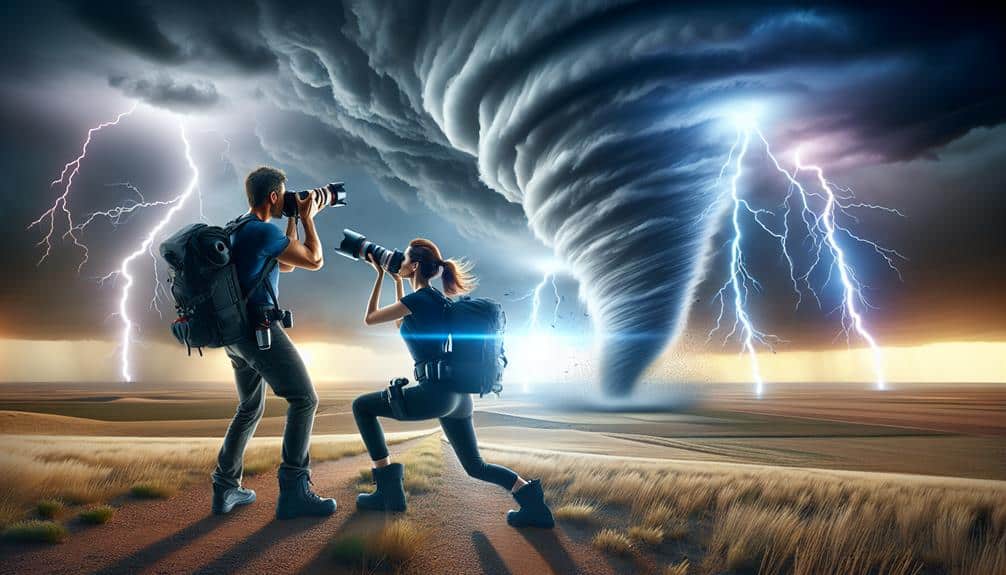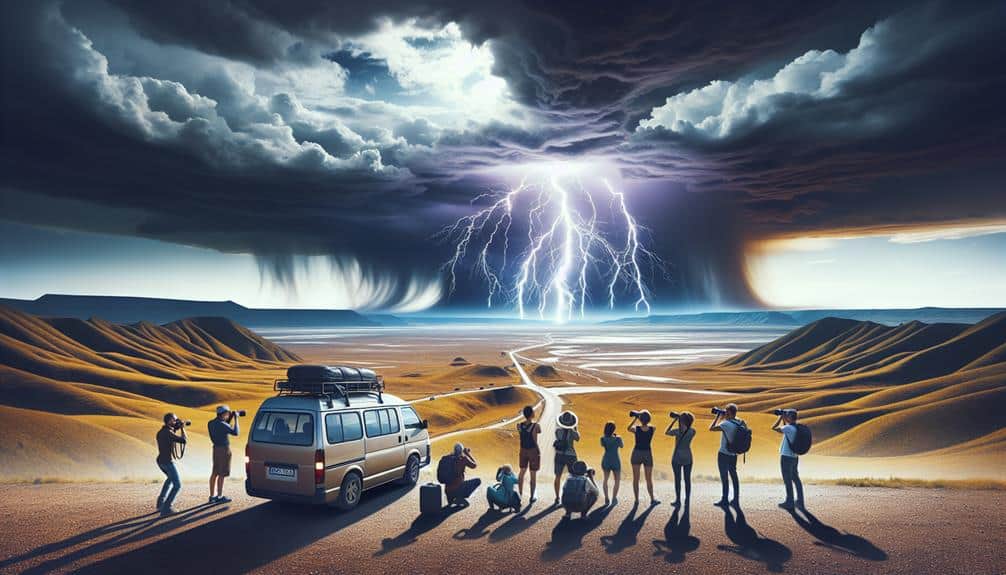When starting a storm chasing tour, we must prioritize safety and preparation. We'll begin by confirming the chasers' credentials and assessing their equipment and insurance. Advanced weather monitoring tools and real-time data are essential for effective storm tracking. Wearing appropriate clothing for the weather and packing necessary gear, including communication tools and first-aid kits, ensures we're prepared for anything. Strict adherence to safety protocols and respect for local communities are non-negotiable. To conclude, we should select reputable tours with strong safety records and remain adaptable to changing weather patterns. For a deeper understanding, every intricate detail reveals crucial insights.
Key Points
- Verify the storm chasers' credentials, certifications, and experience levels to ensure safety and expertise.
- Ensure the tour has comprehensive liability insurance coverage for unforeseen circumstances.
- Utilize advanced storm tracking systems and real-time monitoring tools for accurate and safe storm chasing.
- Adhere to safety protocols, conduct risk assessments, and equip vehicles with necessary safety gear.
Research the Storm Chasers
Before starting storm chasing tours, we need to thoroughly assess the credentials and experience of the storm chasers to make sure they follow safety protocols and possess extensive meteorological knowledge. Evaluating chaser credentials involves examining their educational background, certifications, and field experience. Ideally, our storm chasers should have a background in meteorology or related atmospheric sciences, combined with hands-on storm chasing experience.
Safety is crucial, so we should verify they're certified in first aid and emergency response. Tour reviews are invaluable in this vetting process. By analyzing previous clients' feedback, we can assess the reliability and professionalism of the chasers. Look for reviews that emphasize adherence to safety measures, effective communication, and overall satisfaction with the tour.
Moreover, it's crucial to confirm that the storm chasers use advanced meteorological equipment and data analysis tools to predict storm behavior accurately. This expertise reduces risks and enhances the exhilarating experience we seek.
Let's not forget the importance of insurance coverage; reputable storm chasing tours offer thorough liability insurance. By thoroughly researching these aspects, we can set off on a safe and thrilling storm chasing adventure, confident in our guides' proficiency and reliability.
Check Weather Forecasts
Accurate weather forecasting is crucial for safe and effective storm chasing, as it provides the critical data needed to anticipate storm locations and behaviors. We rely on sophisticated storm tracking systems and real-time weather monitoring tools to guarantee we're always one step ahead of the tempest. High-resolution radar imagery, satellite data, and numerical weather prediction models are the backbone of our forecasting arsenal. These tools allow us to pinpoint supercell developments and predict tornado genesis with remarkable precision.
By constantly updating our weather monitoring protocols, we mitigate risks and enhance our chances of encountering the most dynamic storm systems. We scrutinize atmospheric parameters such as CAPE (Convective Available Potential Energy), wind shear, and dew points, which are essential for identifying severe weather setups. Staying informed through National Weather Service alerts and specialized storm chasing platforms keeps us agile and responsive.
Our commitment to thorough weather forecasting guarantees we maximize our freedom to chase while prioritizing safety. We aren't just thrill-seekers; we're data-driven adventurers who understand the volatile nature of storms. By mastering storm tracking and weather monitoring, we can chase responsibly and experience the raw power of nature without compromising our well-being.
Wear Appropriate Clothing
Equipped with precise weather forecasts, we must also make certain we wear appropriate clothing to protect ourselves from the harsh conditions typical of storm chasing. Dressing appropriately isn't just about comfort; it's about guaranteeing our safety and maximizing our mobility.
We need to choose layers that suit a range of temperatures and weather conditions. Starting with a moisture-wicking base layer can help manage perspiration, keeping us dry and comfortable.
Next, an insulating layer is essential. Fleece or down jackets offer excellent warmth without adding bulk. For the outermost layer, we should opt for a waterproof and windproof shell. This layer provides necessary weather protection against rain, hail, and strong winds, which are all common in storm environments.
Footwear shouldn't be overlooked. Waterproof boots with good traction are a must to navigate muddy or slippery terrain safely. Additionally, we must consider accessories like gloves, hats, and neck gaiters for added comfort and protection.
Clothing comfort and weather protection are paramount in storm chasing. By choosing layers intelligently, we can make certain we're prepared for whatever nature throws our way, allowing us to focus on the exhilarating experience of chasing storms.
Pack Essential Gear
Let's make sure we've packed essential clothing and footwear designed for extreme weather conditions. Safety and navigation tools, like GPS devices and first aid kits, are non-negotiable for our storm chasing expeditions.
We can't afford to overlook these critical items, as they directly influence our safety and effectiveness in the field.
Clothing and Footwear
When packing for storm chasing tours, it's important to prioritize durable, weather-resistant clothing and footwear to guarantee safety and comfort in unpredictable conditions. Our first focus should be on weather protection. A robust, waterproof jacket and pants are non-negotiable; these should be made from breathable, high-performance materials that can withstand heavy rain and high winds.
Layering is key—start with moisture-wicking base layers to keep sweat off your skin, followed by insulating mid-layers like fleece, and finish with a waterproof outer shell.
Next, let's talk about comfortable footwear. A pair of high-quality, waterproof hiking boots with excellent traction is essential. We're often traversing uneven, muddy terrain, so ankle support and slip resistance are essential. Don't forget to pack extra socks—opt for moisture-wicking and quick-drying materials to keep your feet dry and blister-free.
Additionally, consider accessories for added protection. Waterproof gloves, a wide-brimmed hat, and UV-protective sunglasses can make a big difference when facing the elements.
Proper safety and navigation tools are critical for storm chasing, making sure we stay informed, connected, and secure in the field. Our safety equipment should include helmets, first aid kits, and durable gloves to handle debris. Helmets protect us from falling objects, while first aid kits provide immediate care for minor injuries. Gloves are essential for handling sharp or hazardous materials.
Communication devices are indispensable. We rely on two-way radios and satellite phones for real-time updates and to maintain contact with our team, especially in areas with poor cell reception. GPS units and weather apps are non-negotiable. High-precision GPS units allow us to navigate treacherous terrains accurately, while weather apps give us live updates on storm movements and potential hazards.
Let's not forget power sources. Portable chargers and backup batteries for our devices make sure we're never out of touch. A reliable, all-weather notebook and pen are also handy for jotting down observations and coordinates, should electronic devices fail.
Understand Safety Protocols
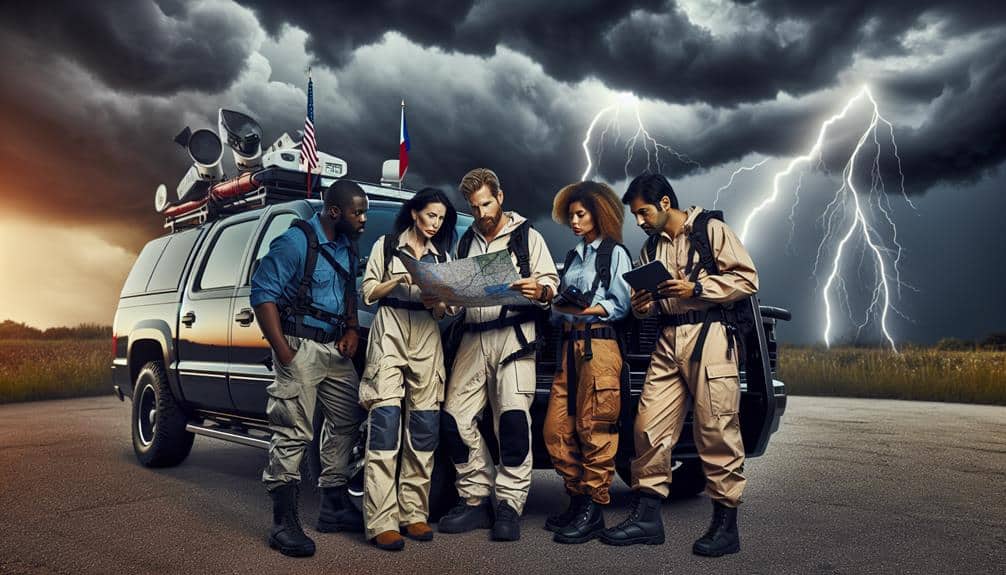
Securing our safety during storm chasing tours necessitates strict adherence to established protocols and real-time weather data analysis. We prioritize thorough emergency procedures and robust communication plans. This guarantees everyone on the tour knows precisely what to do and who to contact if conditions suddenly become hazardous.
Our communication plans include pre-designated check-in times, radio frequencies, and emergency contacts to maintain seamless coordination.
Risk assessment and hazard identification are equally crucial. Before embarking, we analyze meteorological data, searching for signs of severe weather patterns. Throughout the chase, continuous monitoring allows us to pinpoint potential hazards like hail cores, flash floods, and tornado paths. Accurate risk assessment helps us make informed decisions, reducing exposure to life-threatening conditions.
Moreover, our vehicles are equipped with advanced safety gear and first-aid kits. We train extensively in CPR and first aid to guarantee that we can respond effectively in a crisis.
Stay Informed on Storm Paths
Staying informed on storm paths requires continuous analysis of meteorological data and real-time updates from reliable weather forecasting tools. As storm chasers, we need to leverage advanced storm tracking systems and guarantee our emergency preparedness plans are flawless. By staying vigilant, we can maximize our safety and make the most of the chase.
Here's how we can stay informed and prepared:
- Utilize High-Resolution Radar: Accessing high-resolution radar images allows us to track storm cells with precision. Tools like GRLevel3 provide detailed radar data essential for real-time decision-making.
- Monitor Satellite Imagery: Satellite images help us observe storm development over large areas. Platforms like GOES (Geostationary Operational Environmental Satellites) offer vital insights into storm formation and movement patterns.
- Follow Weather Models: Numerical weather prediction models (e.g., GFS, ECMWF) give us forecasts based on atmospheric conditions. Regularly checking these models helps us anticipate changes in storm paths and structure.
- Stay Connected with Weather Alerts: Subscribing to weather alerts from National Weather Service (NWS) or other reliable sources ensures we receive timely updates. These alerts are essential for adapting our plans during the chase.
Capture the Moments
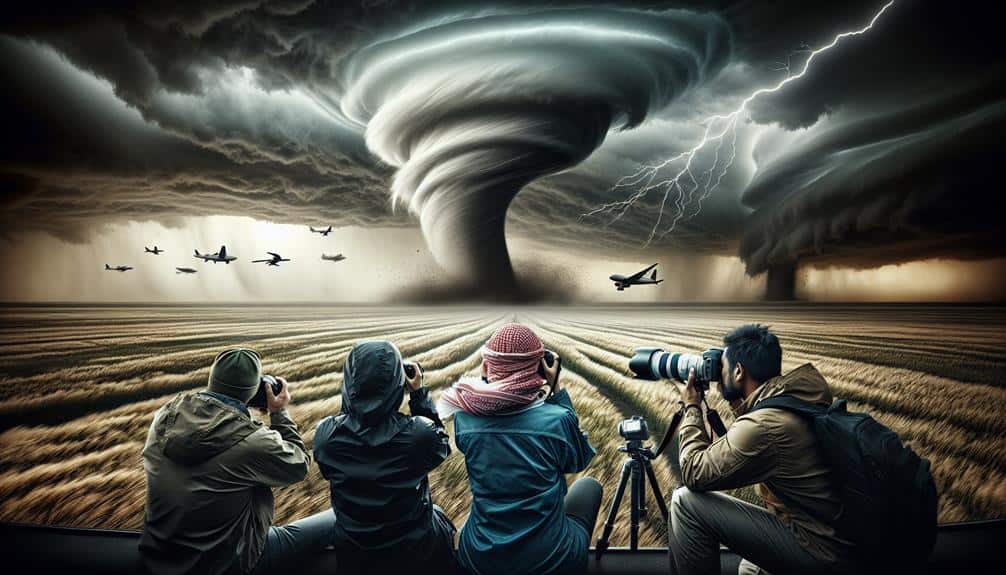
How can we best immortalize the awe-inspiring power of nature while keeping our safety remains paramount?
First, let's prioritize our positioning. We need to stay at a safe distance from the storm's core to avoid debris and hazardous weather. Using telephoto lenses allows us to capture stunning photo opportunities without compromising safety. The adrenaline rush of being close to a storm is exhilarating, but we must always respect the storm's unpredictable nature.
For capturing memories, invest in a sturdy tripod to stabilize your camera against strong winds. Use burst mode to increase the chances of getting that perfect shot of a lightning strike or a funnel cloud. Guarantee our cameras are weather-sealed to protect against rain and dust. Remember to bring extra batteries and memory cards; we don't want to miss documenting any thrilling experiences due to technical failures.
Respect Local Communities
When storm chasing, we must always prioritize respecting the local communities we pass through by minimizing disruption and following all local guidelines. Our actions have a significant impact on community relations and the environment, so adopting a considerate approach is crucial.
Effective community engagement involves interacting respectfully with locals. Always ask for permission when accessing private property and heed any advice or warnings they provide.
Each community has its own cultural norms and values. We should remain aware of these differences and act accordingly to avoid any unintentional disrespect. This enhances our relationship with the community and fosters mutual respect.
Storm chasing often takes us through fragile ecosystems. It's vital that we minimize our footprint by sticking to existing roads and trails, avoiding littering, and ensuring that our vehicles are well-maintained to prevent oil spills or other pollutants.
Local authorities often set specific guidelines for storm chasers to maintain public safety and order. We must comply with these rules, including traffic regulations and emergency procedures, to uphold a positive rapport with the community.
Choose Reliable Tours
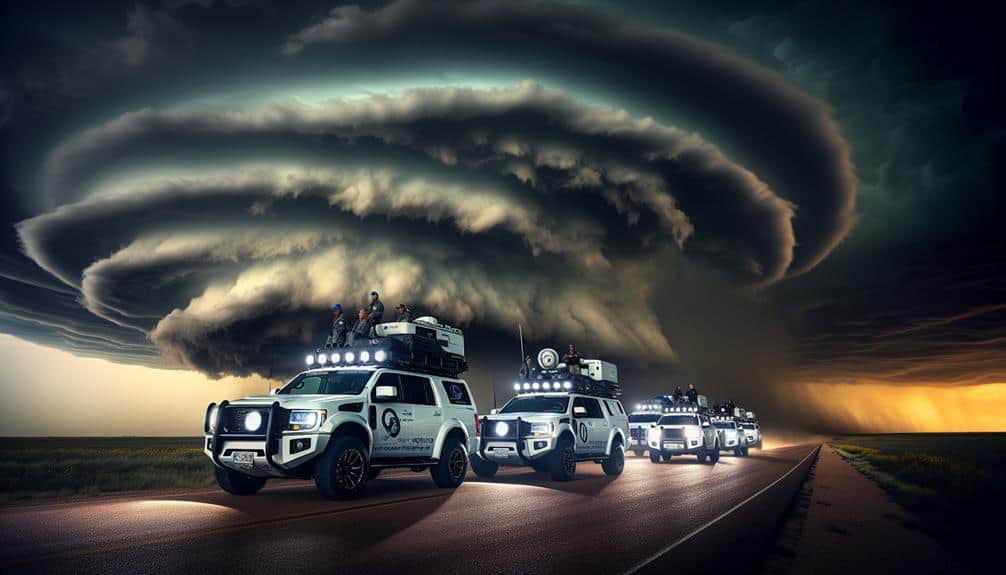
When selecting a storm chasing tour, one crucial aspect to consider is the operator's experience. It is essential to guarantee that they have an extensive track record in meteorology and storm tracking.
It's important to check their safety protocols, including emergency procedures and communication systems. This ensures that they are well-prepared for any unexpected situations that may arise during the tour.
Additionally, evaluating the quality of their equipment, such as radar and vehicles, can greatly influence our safety and the overall success of the tour. High-quality equipment enhances the chances of tracking storms effectively and safely.
Verify Tour Experience
Evaluating a tour company's track record and client testimonials is vital to ensure we choose a reliable storm chasing experience. Before we commit, we need to focus on tour credibility and chaser qualifications.
Experienced guides with a proven history of chasing success are pivotal. Here's what we should look for:
- Professional Qualifications: Verify that the storm chasers have relevant meteorological training and extensive field experience. Credentials from reputable institutions add to their credibility.
- Track Record: Examine how long the tour company has been in operation. Longevity often signifies reliability and sustained success in the field.
- Client Testimonials: Read reviews from past participants to gauge satisfaction levels. Positive feedback about the guides' expertise and the overall experience can be very revealing.
- Chasing Success Rate: While nature is unpredictable, a high success rate in witnessing storms indicates a knowledgeable and skilled team. This reflects their ability to interpret weather patterns accurately.
Check Safety Measures
Securing our safety is paramount, so we need to examine the tour company's safety protocols and emergency preparedness thoroughly. When selecting a trustworthy storm chasing tour, the first step is to assess their emergency procedures. Do they have a clear, structured plan for various emergency scenarios? We should inquire about their risk assessment processes—how do they determine the intensity of a storm and decide on safe versus hazardous conditions?
It's vital to grasp their emergency response capabilities. Are they equipped to handle abrupt changes in weather conditions? What are their communication methods during a chase? Effective real-time communication is critical for relaying updates and ensuring every group member is informed.
Whether it's through two-way radios, satellite phones, or GPS tracking systems, we need to confirm that the tour company maintains robust communication channels.
We should also verify if the tour guides are trained in first aid and other emergency response techniques. Understanding these factors will help us assess the company's dedication to safety.
In the high-risk environment of storm chasing, a reliable tour company prioritizes our safety with thorough plans and clear communication strategies. This guarantees our exciting adventure doesn't jeopardize our well-being.
Assess Equipment Quality
To choose a reliable storm chasing tour, we must scrutinize the quality of their equipment, making sure it meets the highest safety standards. The reliability of the gear used can make the difference between a thrilling adventure and a risky situation. Here's what we need to examine:
- Equipment Maintenance: Regular inspections and upkeep are critical. We should verify that the tour operator performs routine checks on all equipment, ensuring everything is in peak condition. This includes storm tracking instruments and communication devices, which are crucial for real-time updates and emergency coordination.
- Storm Tracking: Advanced tracking systems should be non-negotiable. These systems must have precise radar and GPS capabilities to monitor storm patterns and predict movements accurately. The data provided by these tools guarantees we're always one step ahead of the storm.
- Gear Functionality: All gear, from protective clothing to vehicle modifications, must be fully operational and tailored for storm chasing. We should ask about the specific models and brands they use, as well as any recent upgrades or replacements.
- Communication Devices: Reliable communication is paramount. The tour must be equipped with two-way radios, satellite phones, and other redundant systems to guarantee continuous contact with local authorities and emergency services.
Stay Flexible and Patient
Flexibility and patience are crucial for storm chasers, as weather conditions can change rapidly and unpredictably. Our ability to adapt to the dynamic behavior of storms guarantees our safety and maximizes our chances of witnessing remarkable weather phenomena. Understanding the ever-changing atmospheric variables helps us make informed decisions on the go. We should always be prepared to adjust our plans when the storm's behavior deviates from forecasts.
Tour scheduling is another crucial area where flexibility plays a key role. Weather systems don't adhere to our timetable, so our itinerary must remain flexible. We might need to extend or shorten our chase based on real-time updates. Effective communication among team members and with our tour operator is essential for synchronizing these adjustments. Keeping everyone informed about changes in plans minimizes confusion and enhances safety.
Patience is equally essential. We might spend hours driving or waiting for the ideal storm to develop. Impulsive decisions can lead to missed opportunities or hazardous situations. By staying calm and patient, we increase our chances of success.
Frequently Asked Questions
What Are the Best Months for Storm Chasing Tours?
The best months for storm chasing tours are April through June. During these months, weather patterns are most active. We need to prioritize safety precautions, scout ideal locations, and make sure we have the necessary equipment.
How Long Do Storm Chasing Tours Typically Last?
How long do tours last? Typically, storm chasing tours span 7-10 days. We prioritize safety precautions, closely monitor weather patterns, and guarantee we've got the right equipment needed. This duration maximizes our chase potential while staying safe.
Are Meals Included in Storm Chasing Tour Packages?
Yes, meals are typically included in storm chasing tour packages. Our tour accommodations prioritize your comfort, and we follow strict safety protocols. We make sure you're well-fed and safe while experiencing the thrill of storm chasing.
Can Children Participate in Storm Chasing Tours?
Regarding the current question, children can participate in storm chasing tours, but safety concerns are paramount. We require parental supervision at all times to guarantee compliance with safety protocols and to handle any unpredictable weather situations.
What Is the Average Group Size for a Storm Chasing Tour?
Did you know most storm chasing tours average 6-12 participants? This size optimizes group dynamics and safety precautions. We make sure everyone has the equipment needed and follows strict communication protocols for an exhilarating yet safe adventure.
